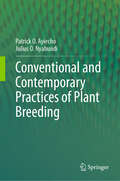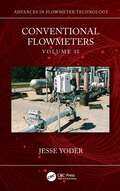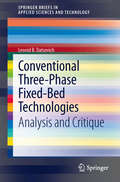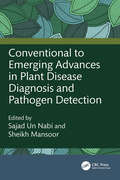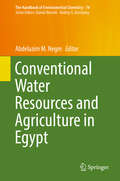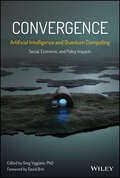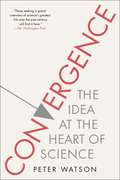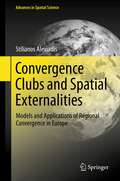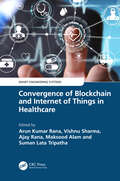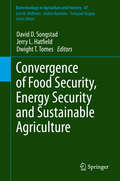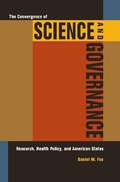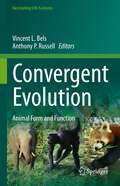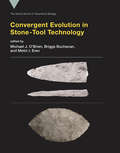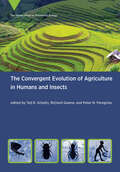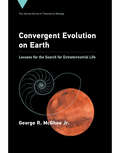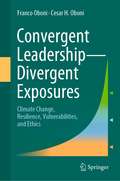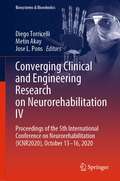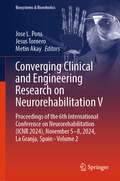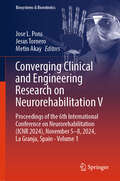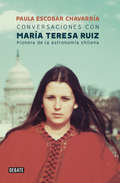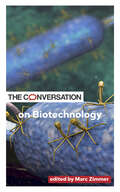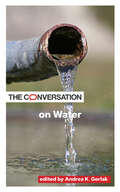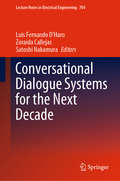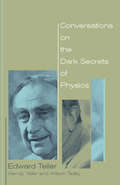- Table View
- List View
Conventional and Contemporary Practices of Plant Breeding
by Patrick O. Ayiecho Julius O. NyabundiThis book covers some established conventional and recent advances in plant breeding methods. It highlights and treats in detail some breeding strategies not adequately handled or usually ignored in many plant breeding texts. There is in-depth coverage of plant resistance mechanisms to various stress factors and application of phenotyping, genotyping, bioinformatics, molecular markers, ‘omics’ technologies, biotechnology, transgenesis and gene editing in crop improvement. Topics like germplasm conservation, plant sex expression and pollination control, recurrent selection methods, interspecific hybridisation, pre-breeding, chromosome manipulation and breeding for resistance to diseases and insect pests are comprehensively covered. The book gives special attention to some problems that affect food security in developing countries, e.g., parasitic weeds and drought and heat stress. Breeding for resistance to parasitic weeds like Striga, broomrapes and Cascuta is always ignored in most plant breeding texts. Where applicable, problems and challenges associated with some breeding strategies are highlighted and possible solutions proposed. The text is rich in relevant examples for various topics. The book is suitable for teaching of plant breeding at the university level and is also beneficial to practising plant breeders. It brings together some relevant work and literary information that is useful to university lecturers, students and practising plant breeders. The book targets university students in agricultural and plant sciences, particularly those taking plant breeding as a key unit/course.
Conventional Flowmeters: Volume II
by Jesse YoderConventional Flowmeters covers origin, principle of operation, development, advantages and disadvantages, applications, and frontiers of research for conventional technology flowmeters, which include differential pressure and primary elements, positive displacement, turbine, open channel, and variable area. There are more conventional technology meters being used in the field than new-technology meters. New developments, such as more accurate pressure transmitters, new primary elements such as cone elements, reversible flow, and dual rotor turbine meters, and variable area meters with transmitters and a signal output, are discussed. Features: Offers a working knowledge of the origin and development of the more traditional technology flowmeters: differential pressure and primary elements, positive displacement, turbine, open channel, and variable area Describes how these conventional meters still fit into what is being called Industry 4.0 Discusses the advantages and disadvantages of conventional technology meters and provides a rationale for retaining or replacing these meters Focuses on the origin, development operating principles, and applications for the meters Explores the development of each conventional flowmeter type, including the roles of companies such as Siemens, ABB, Emerson, Foxboro, KROHNE, and Endress+Hauser This book is designed for anyone involved with flowmeters and instrumentation, including product and marketing managers, strategic planners, application engineers, and distributors.
Conventional Three-Phase Fixed-Bed Technologies: Analysis and Critique (SpringerBriefs in Applied Sciences and Technology #7)
by Leonid B. DatsevichThis book analyzes conventional fixed-bed reactors such as trickle-bed, bubble (packed) column, and multitubular reactors with regard to process efficiency, design and safety. It is shown that these reactors do not possess any substantial potential for improving industrial processes. Modern concepts in mass transfer, kinetics and process design are applied to process development. In light of the given analysis, new approaches to the development of technologies based on innovative principles are elucidated. For the first time, first-hand knowledge about Two-Zone Model, Oscillation Theory, map of the energy dissipation is presented in full.
Conventional to Emerging Advances in Plant Disease Diagnosis and Pathogen Detection
by Sajad Un Nabi Sheikh MansoorDiseases in crops cause significant economic losses by decreasing both the yield and quality of produce. Early and accurate diagnosis of these diseases is crucial, as it enhances the effectiveness of management strategies and helps prevent long-term damage to infected plants. The need for precise, swift, and efficient methods for diagnosing diseases and detecting pathogens remains a top priority. Conventional to Emerging Advances in Plant Disease Diagnosis and Pathogen Detection comprehensively addresses key diagnostic methods and pathogen detection techniques, from their origins to the present, guiding us toward the future of plant diagnostics. It serves as a valuable resource for academics, extension workers, and growers, offering the latest information on developments in disease diagnosis and pathogen detection.The chapters within this volume offer a comprehensive journey through the historical perspectives and groundbreaking innovations that have shaped disease diagnosis. We traverse the conventional methods that have laid the foundation for our understanding, and then embark on a journey through emerging technologies that promise to revolutionize the field. This compilation aims to connect traditional knowledge with the latest technological advancements, offering a comprehensive view of the trajectory of plant disease diagnosis. Created through collaborative efforts of field experts sharing insights and experiences, this resource is not only informative but also forward-thinking. Features Comprehensive coverage of both traditional and contemporary diagnostic techniques for identifying plant diseases and detecting pathogens. Detailed exploration of the latest advancements and innovations in disease diagnosis and pathogen detection, providing up-to-date knowledge. In-depth discussion of cutting-edge diagnostic strategies, including artificial intelligence, machine learning, biosensors, next-generation sequencing, point-of-care assays, and CRISPR-Cas systems. Abundantly illustrated with diagrams, flowcharts, and representations to support field identification and precise diagnosis of plant diseases.
Conventional Water Resources and Agriculture in Egypt (The Handbook of Environmental Chemistry #74)
by Abdelazim M. NegmThis unique volume focuses on Egypt’s conventional water resources and the main water consumer: Egypt’s agriculture. It provides an up-to-date overview and the latest research findings, and covers the following main topics: · History of irrigation and irrigation projects · Key features of agriculture, the administrative and legal framework in Egypt · Land resources for agriculture development · Food insecurity due to water shortages and climate change; resulting challenges and opportunities · Assessment of water resources for irrigation and drinking purposes · Impacts of upstream dams, such as the GERD and Tekeze Dam, on Egypt’s water resources and crop yield · Sustainable use of water resources and the future of mega irrigation projects · Quantity and quality of water in Egypt’s water resources bank This book and the companion volume Unconventional Water Resources and Agriculture in Egypt offer invaluable reference guides for postgraduates, researchers, professionals, environmental managers and policymakers interested in water resources and their management worldwide.
Convergence: Social, Economic, and Policy Impacts
by Greg ViggianoPrepare for the coming convergence of AI and quantum computing A collection of essays from 20 renowned, international authors working in industry, academia, and government, Convergence: Artificial Intelligence and Quantum Computing explains the impending convergence of artificial intelligence and quantum computing. A diversity of viewpoints is presented, each offering their view of this coming watershed event. In the book, you&’ll discover that we&’re on the cusp of seeing the stuff of science fiction become reality, with huge implications for ripping up the existing social fabric, global economy, and current geopolitical order. Along with an incisive foreword by Hugo- and Nebula-award winning author David Brin, you&’ll also find: Explorations of the increasing pace of technological development Explanations of why seemingly unusual and surprising breakthroughs might be just around the corner Maps to navigate the potential minefields that await us as AI and quantum computing come togetherA fascinating and thought-provoking compilation of insights from some of the leading technological voices in the world, Convergence convincingly argues that we should prepare for a world in which very little will remain the same and shows us how to get ready.
Convergence: The Idea at the Heart of Science
by Peter WatsonA brilliant history of science over the past 150 years that offers a powerful new argument—that the many disparate scientific branches are converging on the same truths.Convergence is a history of modern science with an original and significant twist. Various scientific disciplines, despite their very different beginnings, have been coming together over the past 150 years, converging and coalescing. Intimate connections have been discovered between physics and chemistry, psychology and biology, genetics and linguistics. In this groundbreaking book, Peter Watson identifies one extraordinary master narrative, capturing how the sciences are slowly resolving into one overwhelming, interlocking story about the universe. Watson begins his narrative in the 1850s, the decade when, he argues, the convergence of the sciences began. The idea of the conservation of energy was introduced in this decade, as was Darwin’s theory of evolution—both of which rocketed the sciences forward and revealed unimagined interconnections and overlaps between disciplines. The story then proceeds from each major breakthrough and major scientist to the next, leaping between fields and linking them together. Decade after decade, the story captures every major scientific advance en route to the present, proceeding like a cosmic detective story, or the world’s most massive code-breaking effort. Watson’s is a thrilling new approach to the history of science, revealing how each piece falls into place, and how each uncovers an “emerging order.” Convergence is, as Nobel Prize-winning physicist Steven Weinberg has put it, “The deepest thing about the universe.” And Watson’s comprehensive and eye-opening book argues that all our scientific efforts are indeed approaching unity. Told through the eyes of the scientists themselves, charting each discovery and breakthrough, it is a gripping way to learn what we now know about the universe and where our inquiries are heading.
Convergence Clubs and Spatial Externalities: Models and Applications of Regional Convergence in Europe (Advances in Spatial Science)
by Stilianos AlexiadisDo dynamic externalities, in the form of technology creation, adoption and spatial agglomeration shape the pattern of regional growth in Europe? This study provides an alternative view on regional convergence. A model is developed which attributes club-convergence to existing differences with respect to the degree of technology adoption. In the first instance, empirical results suggest that the NUTS-2 regions of the EU-27 converge at a very slow rate. Further tests, however, indicate that convergence is restricted to a specific subset of regions. Such conclusions are tested further, using an alternative model of club-convergence, which incorporates the impact of spatial interaction, agglomeration externalities and technology. This shows that the convergence-club in Europe follows a certain geographical pattern and all members share similar characteristics regarding technology creation and adoption, and agglomeration externalities.
Convergence of Blockchain and Internet of Things in Healthcare (Smart Engineering Systems: Design and Applications)
by Arun Kumar Rana, Vishnu Sharma, Ajay Rana, Maksud Alam and Suman Lata TripathiThe Internet of Things (IoT) and blockchain are two new technologies that combine elements in many ways. A system where the virtual and physical worlds interact is created by integrating pervasive computing, ubiquitous computing, communication technologies, sensing technologies, Internet Protocol, and embedded devices. A massive number of linked devices and vast amounts of data present new prospects for developing services that can directly benefit the economy, environment, society, and individual residents. Due to the size of IoT and insufficient data security, security breaches may have a huge impact and negative effects. IoT not only connects gadgets but also people and other entities, leaving every IoT component open to a wide variety of assaults. The implementation and application of IoT and blockchain technology in actual scientific, biomedical, and data applications are covered in this book. The book highlights important advancements in health science research and development by applying the distinctive capabilities inherent to distributed ledger systems. Each chapter describes the current uses of blockchain in real-world data collection, medicine development, device tracking, and more meaningful patient interaction. All of these are used to create opportunities for expanding health science research. This paradigm change is studied from the perspectives of pharmaceutical executives, biotechnology entrepreneurs, regulatory bodies, ethical review boards, and blockchain developers.Key Features: Provides a foundation for the implementation process of blockchain and IoT devices based on healthcare-related technology Image processing and IoT device researchers can correlate their work with other requirements of advanced technology in the healthcare domain Conveys the latest technology, including artificial intelligence and machine learning, in healthcare-related technology Useful for the researcher to explore new things like security, cryptography, and privacy in healthcare related technology Tailored for people who want to start in healthcare-related technology with blockchain and IoT This book is primarily for senior undergraduates, graduate students, and academic researchers in the fields of electrical engineering, electronics and communication engineering, computer science and engineering, and biomedical engineering.
Convergence of Food Security, Energy Security and Sustainable Agriculture (Biotechnology in Agriculture and Forestry #67)
by Jerry L. Hatfield David D. Songstad Dwight T. TomesThis volume examines the interrelated fields of food security, energy security and sustainable agriculture as the key to a stable global agricultural platform and is arranged in six parts The first part is focused on policy considerations relating to food and energy security and sustainable agriculture The authors from this part include Former Under Secretary of Agriculture Gale Buchanan, Former Under Secretary of Energy Raymond Orbach (Chapter 1), Stephen Hughes, Bryan Moser and William Gibbons (Chapter 2) and Thomas Redick (Chapter 3) Part II addresses soil and water, which are two of the key components in secure and sustainable food production Authors from this part are Jerry Hatfield (Chapter 4) and Mahbub Alam, Sharon Megdal et al. (Chapter 5) The third part covers sustainable and secure food production specifically addressing genetically modified traits in Chapter 6 (James McWilliams) and omega-3 fatty acids in Chapter 7 (Jay Whelan et al. ) Agronomic implications relative to food security and sustainable agriculture are described in Part IV Authors include Ravi Sripada, Pradip Das et al. (Chapter 8), Duska Stojsin, Kevin Matson and Richard Leitz (Chapter 9) and S. H. Lee, David Clay and Sharon Clay (Chapter 10) International sustainable agriculture and food security is addressed in Part V with authors Jeff Vitale and John Greenplate (Chapter 11), Julie Borlaug et al. (Chapter 12) and Sylvester Oikeh et al. (Chapter 13) The final part covers the use of chemicals in sustainable agriculture and food/energy security with Leonard Gianessi and Ashley Williams communicating the role of herbicides and Harold Reetz emphasizing the importance of fertilizers both in maximizing crop yields to maintain a sustainable secure source for food production.
The Convergence of Science and Governance: Research, Health Policy, and American States
by Daniel M. FoxThis book tells related stories about health politics and policy in the U.S.during the past century--the recent convergence of science and governance in policy for covering pharmaceutical drugs in public programs in most American states and explain why and how this convergence occurred.
Convergent Evolution: Animal Form and Function (Fascinating Life Sciences)
by Vincent L. Bels Anthony P. RussellThis volume presents a series of case studies, at different levels of inclusivity, of how organisms exhibit functional convergence as a key evolutionary mechanism resulting in responses to similar environmental constraints in mechanically similar ways. The contributors to this volume have selected and documented cases of convergent evolution of form and function that are perceived to be driven by environmental abiotic and/or biotic challenges that fall within their areas of expertise. Collectively these chapters explore this phenomenon across a broad phylogenetic spectrum. The sequence of chapters follows the organizational principle of increasing phylogenetic inclusivity, rather than the clustering of chapters by perceived similarity of the phenotypic features or biomechanical challenges being considered. This is done to maintain focus on the evolutionary phenomenon that is the primary subject matter of the book, thereby providing a basis for discussion among the readership about what is necessary and sufficient to justify the recognition of functional convergence. All chapters stress the need for integrative approaches for the elucidation of both pattern and process as they relate to convergence at various taxonomic levels.
Convergent Evolution in Stone-Tool Technology (Vienna Series in Theoretical Biology #22)
by Michael O'Brien Briggs Buchanan Metin ErenScholars from a variety of disciplines consider cases of convergence in lithic technology, when functional or developmental constraints result in similar forms in independent lineages. Hominins began using stone tools at least 2.6 million years ago, perhaps even 3.4 million years ago. Given the nearly ubiquitous use of stone tools by humans and their ancestors, the study of lithic technology offers an important line of inquiry into questions of evolution and behavior. This book examines convergence in stone tool-making, cases in which functional or developmental constraints result in similar forms in independent lineages. Identifying examples of convergence, and distinguishing convergence from divergence, refutes hypotheses that suggest physical or cultural connection between far-flung prehistoric toolmakers. Employing phylogenetic analysis and stone-tool replication, the contributors show that similarity of tools can be caused by such common constraints as the fracture properties of stone or adaptive challenges rather than such unlikely phenomena as migration of toolmakers over an Arctic ice shelf.ContributorsR. Alexander Bentley, Briggs Buchanan, Marcelo Cardillo, Mathieu Charbonneau, Judith Charlin, Chris Clarkson, Loren G. Davis, Metin I. Eren, Peter Hiscock, Thomas A. Jennings, Steven L. Kuhn, Daniel E. Lieberman, George R. McGhee, Alex Mackay, Michael J. O'Brien, Charlotte D. Pevny, Ceri Shipton, Ashley M. Smallwood, Heather Smith, Jayne Wilkins, Samuel C. Willis, Nicolas Zayns
The Convergent Evolution of Agriculture in Humans and Insects (Vienna Series in Theoretical Biology)
by Ted R. Schultz, Richard Gawne, and Peter N. PeregrineContributors explore common elements in the evolutionary histories of both human and insect agriculture resulting from convergent evolution.During the past 12,000 years, agriculture originated in humans as many as twenty-three times, and during the past 65 million years, agriculture also originated in nonhuman animals at least twenty times and in insects at least fifteen times. It is much more likely that these independent origins represent similar solutions to the challenge of growing food than that they are due purely to chance. This volume seeks to identify common elements in the evolutionary histories of both human and insect agriculture that are the results of convergent evolution. The goal is to create a new, synthetic field that characterizes, quantifies, and empirically documents the evolutionary and ecological mechanisms that drive both human and nonhuman agriculture. The contributors report on the results of quantitative analyses comparing human and nonhuman agriculture; discuss evolutionary conflicts of interest between and among farmers and cultivars and how they interfere with efficiencies of agricultural symbiosis; describe in detail agriculture in termites, ambrosia beetles, and ants; and consider patterns of evolutionary convergence in different aspects of agriculture, comparing fungal parasites of ant agriculture with fungal parasites of human agriculture, analyzing the effects of agriculture on human anatomy, and tracing the similarities and differences between the evolution of agriculture in humans and in a single, relatively well-studied insect group, fungus-farming ants.
Convergent Evolution on Earth: Lessons for the Search for Extraterrestrial Life (Vienna Series in Theoretical Biology #24)
by George R. McGheeAn analysis of patterns of convergent evolution on Earth that suggests where we might look for similar convergent forms on other planets.Why does a sea lily look like a palm tree? And why is a sea lily called a “lily” when it is a marine animal and not a plant? Many marine animals bear a noticeable similarity in form to land-dwelling plants. And yet these marine animal forms evolved in the oceans first; land plants independently and convergently evolved similar forms much later in geologic time. In this book, George McGhee analyzes patterns of convergent evolution on Earth and argues that these patterns offer lessons for the search for life elsewhere in the universe.Our Earth is a water world; 71 percent of the earth's surface is covered by water. The fossil record shows that multicellular life on dry land is a new phenomenon; for the vast majority of the earth's history—3,500 million years of its 4,560 million years of existence—complex life existed only in the oceans. Explaining that convergent biological evolution occurs because of limited evolutionary pathways, McGhee examines examples of convergent evolution in forms of feeding, immobility and mobility, defense, and organ systems. McGhee suggests that the patterns of convergent evolution that we see in our own water world indicate the potential for similar convergent forms in other water worlds. We should search for extraterrestrial life on water worlds, and for technological life on water worlds with continental landmasses.
Convergent Leadership-Divergent Exposures: Climate Change, Resilience, Vulnerabilities, and Ethics
by Franco Oboni Cesar H. OboniThis book aims, through its chapters, at providing the knowledge to make competent decisions, convince peers or top management to take appropriate action, or beat out the competition for climate adaptation measures including adjustments for design and operations. Topics discussed include business-as-usual vs. divergence; the effects of public pressure on corporate, industrial and government decision making; techniques for gathering the proper information to assess risks and hazards; the importance determining risk tolerance thresholds; the difference between tolerable risks, intolerable ones that benefit from mitigation and those that require strategic shifts; why common practice approaches such as FMEA, and risk matrices are inadequate in today’s world and do not help ensure infrastructural and systemic resilience and sustainability.Case histories and three complete case studies that can be adapted to any industry or project walk the reader step by step from client request to recommendations and conditions of validity. The ultimate aim is to understand how to reduce risks to tolerable and societally acceptable levels while simultaneously creating sustainable and ethical systems.
Converging Clinical and Engineering Research on Neurorehabilitation IV: Proceedings of the 5th International Conference on Neurorehabilitation (ICNR2020), October 13–16, 2020 (Biosystems & Biorobotics #28)
by Diego Torricelli Metin Akay Jose L. PonsThe book reports on advanced topics in the areas of neurorehabilitation research and practice. It focuses on new methods for interfacing the human nervous system with electronic and mechatronic systems to restore or compensate impaired neural functions. Importantly, the book merges different perspectives, such as the clinical, neurophysiological, and bioengineering ones, to promote, feed and encourage collaborations between clinicians, neuroscientists and engineers. Based on the 2020 International Conference on Neurorehabilitation (ICNR 2020) held online on October 13-16, 2020, this book covers various aspects of neurorehabilitation research and practice, including new insights into biomechanics, brain physiology, neuroplasticity, and brain damages and diseases, as well as innovative methods and technologies for studying and/or recovering brain function, from data mining to interface technologies and neuroprosthetics. In this way, it offers a concise, yet comprehensive reference guide to neurosurgeons, rehabilitation physicians, neurologists, and bioengineers. Moreover, by highlighting current challenges in understanding brain diseases as well as in the available technologies and their implementation, the book is also expected to foster new collaborations between the different groups, thus stimulating new ideas and research directions.
Converging Clinical and Engineering Research on Neurorehabilitation V: Proceedings of the 6th International Conference on Neurorehabilitation (ICNR 2024), November 5–8, 2024, La Granja, Spain - Volume 2 (Biosystems & Biorobotics #32)
by Jose L. Pons Jesus Tornero Metin AkayThe book reports on advanced topics in the areas of neurorehabilitation research and practice. It focuses on new methods for interfacing the human nervous system with electronic and mechatronic systems to restore or compensate impaired neural functions. Importantly, the book merges different perspectives, such as the clinical, neurophysiological, and bioengineering ones, to promote, feed and encourage collaborations between clinicians, neuroscientists and engineers. Based on the 2024 International Conference on Neurorehabilitation (ICNR2024) held in La Granja, Spain on November 5-8, 2024, this book covers various aspects of neurorehabilitation research and practice, including new insights into biomechanics, brain physiology, neuroplasticity, and brain damages and diseases, as well as innovative methods and technologies for studying and/or recovering brain function, from data mining to interface technologies and neuroprosthetics. In this way, it offers a concise, yet comprehensive reference guide to neurosurgeons, rehabilitation physicians, neurologists, and bioengineers. Moreover, by highlighting current challenges in understanding brain diseases as well as in the available technologies and their implementation, the book is also expected to foster new collaborations between the different groups, thus stimulating new ideas and research directions.
Converging Clinical and Engineering Research on Neurorehabilitation V: Proceedings of the 6th International Conference on Neurorehabilitation (ICNR 2024), November 5–8, 2024, La Granja, Spain - Volume 1 (Biosystems & Biorobotics #31)
by Jose L. Pons Jesus Tornero Metin AkayThe book reports on advanced topics in the areas of neurorehabilitation research and practice. It focuses on new methods for interfacing the human nervous system with electronic and mechatronic systems to restore or compensate impaired neural functions. Importantly, the book merges different perspectives, such as the clinical, neurophysiological, and bioengineering ones, to promote, feed and encourage collaborations between clinicians, neuroscientists and engineers. Based on the 2024 International Conference on Neurorehabilitation (ICNR2024) held in La Granja, Spain on November 5-8, 2024, this book covers various aspects of neurorehabilitation research and practice, including new insights into biomechanics, brain physiology, neuroplasticity, and brain damages and diseases, as well as innovative methods and technologies for studying and/or recovering brain function, from data mining to interface technologies and neuroprosthetics. In this way, it offers a concise, yet comprehensive reference guide to neurosurgeons, rehabilitation physicians, neurologists, and bioengineers. Moreover, by highlighting current challenges in understanding brain diseases as well as in the available technologies and their implementation, the book is also expected to foster new collaborations between the different groups, thus stimulating new ideas and research directions.
Conversaciones con María Teresa Ruiz
by Paula Escobar Maria Teresa RuizUn diálogo que repasa la trayectoria vital y profesional de la astrónoma y científica chilena más relevante de la última década Durante los últimos años, María Teresa Ruiz se ha convertido en una figura icónica de la astronomía. Ha sido «la primera» en múltiples ocasiones: desde la primera licenciada en astronomía y primera doctora en astrofísica de dos universidades, pasando por ser la primera mujer en obtener el premio nacional de ciencias hasta el premio de la UNESCO "Mujeres en la ciencia", que ha consolidado su reputación a nivel internacional. En estas conversaciones, Paula Escobar indaga en aspectos desconocidos e inéditos, hasta ahora, de la vida y obra de nuestra astrónoma más reconocida. Reseña: "Este diálogo constituye un paseo por el pasado, el presente y el futuro de la astronomía chilena."
The Conversation on Biotechnology (Critical Conversations)
by Marc ZimmerFrom the contributors to The Conversation, this collection of essays by leading experts in biotechnology provides foundational knowledge on a range of topics, from CRISPR gene sequencing to the ethics of GMOs and "designer babies."In The Conversation on Biotechnology, editor Marc Zimmer collects essays from The Conversation U.S. by top scholars and experts in the field, who present a primer on the latest biotechnology research, the overwhelming possibilities it offers, and the risks of its abuse. From an overview of CRISPR technology and gene editing in GMOs to the ethical questions surrounding "designer babies" and other applications of biotechnology in humans, it highlights the major implications biotechnology will bring for health and society. Topics range from the spectacular use of light to fire individual neurons in the brain to making plant-based meats; from curbing diseases with genetically modified mosquitoes to looking back on 40 years of opinions on IVF babies.The Critical Conversations series collects essays from top scholars on timely topics, including water, biotechnology, gender diversity, gun culture, and more, originally published on the independent news site The Conversation U.S.Contributors: Nathan Ahlgren, Ivan Anishchenko, Trine Antonsen, Jennifer Barfield, Pedro Belda-Ferre, Ari Berkowitz, Adeline Boettcher, Jason Delbourne, Kevin Doxzen, Mo Ebrahimkhani, Eleanor Feingold, J. Benjamin Hurlbut, Cecile Janssens, Samira Kiani, Amanda Kowalczyk, Mariana Lamas, Andrew Lapworth, Rebecca Mackelprang, Kathleen Merrigan, Saman Naghieh, Sean Nee, Dimitri Perrin, Christopher Preston, Jason Rasgon, Penny Riggs, Jason Robert, Oliver Rogoyski, Gary Samore, Sahotra Sarkar, George E. Seidel, Patricia A. Stapleton, Craig W. Stevens, Paul B. Thompson, Christopher Tuggle, Vikramaditya G. Yadav, Marc Zimmer
The Conversation on Water (Critical Conversations)
by Andrea K. GerlakFrom the contributors to The Conversation, a compelling essay collection on the world's water crises and the necessary steps to build a more sustainable and equitable water future for all.Water-related crises are affecting more and more communities, both in the United States and internationally. If we continue to delay upgrading our infrastructure and addressing rising environmental concerns, we risk further destabilizing already strained systems—or, worse, causing a catastrophic collapse. In The Conversation on Water, water scholar and professor Andrea K. Gerlak collects essays from The Conversation U.S. on critical issues related to water from leading experts in everything from public policy to environmental engineering.Gerlak pays special attention to the threats facing our water systems today—covering insufficient infrastructure, climate change, and pollution—and integrates them with essays on technologies for harvesting water and Indigenous knowledge in governing the oceans. She then proposes solutions that present opportunities for hope and reform. From new partnerships and collaborative efforts to alternative governance practices and new scientific tools and community approaches, readers will learn about viable pathways forward and will understand the deep social and political dimensions of water governance. Understanding these challenges is the first step toward building a more sustainable and equitable water future for all. The Critical Conversations series collects essays from top scholars on timely topics, including water, biotechnology, gender diversity, gun culture, and more, originally published on the independent news site The Conversation U.S. Contributors: Roger Bales, Kevin Befus, Robert Blasiak, Ellen Bruno, Bethany Caruso, Sebastien Chastin, Craig E. Colten, Joseph Cook, Michelle DiBenedetto, Farshid Felfelani, Gabriel Filippelli, Michail Georgiou, Burke Griggs, Gary Griggs, Drew Gronewold, Marissa Grunes, Danielle Hare, Brian Haus, Dan Johnson, Carol Kwiatkowski, Rosalyn R. LaPier, Katharine Mach, Amahia Mallea, Daniel McCool, Jacob Miller-Klugesherz, Nobuhito Mori, Thomas Mortlock, Suzanne O'Connell, Itxaso Odériz, Joseph D. Ortiz, Meg Parsons, Raquel Partelli-Feltrin, Yadu Pokhrel, Manzoor Qadir, Julie Reimer, Landolf Rhode-Barbarigos, Richard Rood, Asher Rosinger, Matthew R. Sanderson, Heidi Schweizer, Alan Seltzer, A. R. Siders, Rodolfo Silva-Casarín, Vladimir Smakhtin, Bruce Sutherland, Lara Taylor, Emily Ury, Ton Van den Bremer, Andrew J. Whelton
Conversation Pieces
by Mark CarnallThis book, beautifully illustrated with specially commissioned photography, is a celebration of UCL's unique collections, with leading academics from the university invited to select and write about an object each found inspiring. From a jar of moles to an Egyptian unguent spoon, a finger X-ray to some prehistoric cereal grains, their choices were often surprising, their responses always fascinating.
Conversational Dialogue Systems for the Next Decade (Lecture Notes in Electrical Engineering #704)
by Luis Fernando D’Haro Zoraida Callejas Satoshi NakamuraThis book compiles and presents a synopsis on current global research efforts to push forward the state of the art in dialogue technologies, including advances to the classical problems of dialogue management, language generation, question answering, human–robot interaction, chatbots design and evaluation, as well as topics related to the human nature of the conversational phenomena such as humour, social context, specific applications for e-health, understanding, and awareness
Conversations on the Dark Secrets of Physics
by Edward Teller Wendy Teller Wilson TalleyIn Conversations on the Dark Secrets of Physics, Teller returns to the fundamentals of physics to share with readers his unbridled enthusiasm for the world of physical reality--from the nature of molecules to quantum mechanics and superconductors, from the elementary laws of thermodynamics to how planets, asteroids, and comets develop their orbits. By simplifying the math and forgoing the often-confusing technical jargon, Teller helps the reader break through physic's bewildering formulas and equations and get to the wonders of our physical universe. A timeless and personal explanation of the importance of physics in our life, Conversations on the Dark Secrets of Physics is certain to become a classic.
